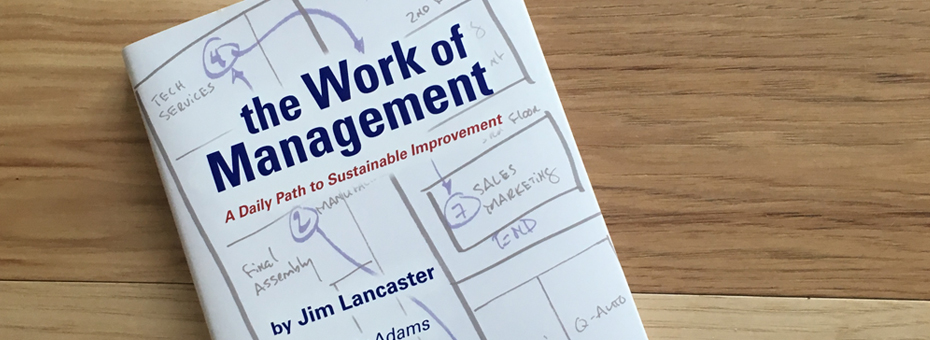I’ve recently become addicted to the electronic distance and step-measuring device on my wrist. Before my children insisted I get one, I had been a devout daily walker – one form of walking being the gemba walk in pursuit of yokoten. But now I’m totally, absolutely devout. Every day, all day the device tells me how I am progressing toward my goal of 10,000 steps, which helps me to quickly change my plans to get back on pace if I fall off. It’s the daily expectation that I will meet my goal and the through-the-day feedback on how I’m progressing toward my goal, with its spur to immediate corrective action, that has made a big difference in my behavior. I was always a devout walker in theory, but often came up short. Now I’m a devout walker in practice and almost always meet my goal.
At the same time I’ve become pace obsessed with walking, I’ve been working as the editorial advisor on a new LEI book by Jim Lancaster, The Work of Management – A Daily Path to Sustainable Improvement, to be showcased at the Lean Transformation Summit on March 7. This book describes a daily management system involving three management walks running horizontally across all the departments in a value-creating organization (Lantech). This cycle – at the beginning of the day in each work area, a bit later in each department (comprising many work areas), and then at mid-morning across all the departments in the business – runs every day at a precise time and steady pace to spot any deterioration in performance the previous day, compared with historic run rates, and to get back on pace immediately. (This is the organizational equivalent of the device on my wrist.)
As we approach the 20th anniversary of the Lean Enterprise Institute this summer, I believe that effective daily management to sustain stable performance – achieved through the three layers of daily management walks on a steady pace with immediate corrective action, as described in the book – is the biggest gap in practice in the Lean Community. This seems curious given the focus of lean thinking from the beginning on determining takt time for each operation (the amount of a given activity that needs to be performed in a day divided into the time in the day available to perform it.) In addition, many organizations introduced production control boards in work areas and departments a decade or more ago with hour-by-hour and daily expectations about performance. (These, of course, are simply low-volume extensions of lean assembly-line practice for high-volume production where team leaders respond to production shortfalls, as signaled by andon, in only a few seconds and within takt time.) Surely we are all thinking about a stable, steady pace and how to sustain it.
So what’s the problem? I believe that the root cause is an inadequate understanding of the work of management. I find that most line managers still see their job as constructing score boards for performance, making sure the scoreboards have up-to-date numbers, rewarding subordinates for good performance, and referring problems to some staff group (or even consultants) when performance falls off the needed pace over an extended period.
This is yet another manifestation of the belief of modern managers that they can manage by results, without actually understanding the front-line value-creating work, and can delegate the critical management work of countermeasuring problems – which means stabilizing each value-creating process – to others. Let me give an example.
In recent years I’ve made many visits to Company A, which is attempting a lean transformation. And I think it is fair to say that this organization is now lean in theory. But as I observe their daily management walks at the area and department levels I still see the same thing: The daily and hourly production control boards are always up to date and the cause of each shortfall in production is neatly written on the right side of the board. And…the problems are usually the same day after day: missing parts, ill-fitting parts, downtime for the same reason on the same machine. So I always ask: “Who is responsible for addressing these problems?” And I’m always told: “The operational excellence team, which is Pareto-ing the data over time to decide which are the most important problems to focus on.” Meanwhile, the operations have daily short falls in production as old problems recur and new problems arise and the company runs overtime to meet customer demand.
What should these line managers be doing instead? Developing their skills so that they understand enough about the front-line work to help production teams immediately introduce a countermeasure to get production stabilized and back on pace. If the countermeasure holds there will be no need to add the problem to the Pareto list. Only if the problem recurs and requires complex data gathering is it a candidate for deeper investigation by staff experts.
This gap in management thinking about work – giving rise to the “bored walk” of managers staring daily at the same problems while doing nothing – really came into focus in my mind some years ago when an ex-Toyota TPS expert joined the cross-department morning walk at Company A. As the line managers stared at a problem listed on a board he asked, “Why don’t you countermeasure this problem right now?” There was a look of incredulity in the group, with one manager saying, “But the purpose of the board is to flag the problem so OpEx can work on it later.” Fortunately, the Toyota veteran persisted and insisted that the cross-facility management team on the morning walk visit the process fabricating the missing part in another department. In a few minutes it became apparent that the problem was a missing parts bin in the two-bin replenishment system. As a result parts shortages were inevitable. In five minutes the problem was countermeasured with addition of a second bin. No OpEx team needed. No need to consult long-dead Valfredo Pareto. No time lag in restoring stable performance.
Why is it so important for managers to countermeasure problems in real time rather than defer them? Because this is the key to creating basic stability in every process so that managers can spend their time actually improving performance, rather than endlessly measuring the performance of broken processes. What I see over and over again is the exact opposite approach: Companies start with a big annual vision of how they can improve their business through hoshin planning (“Let’s try some kaikaku!”), but the hoshin plans can’t actually be implemented because there is too much chaos in the existing value-creating systems. So the managers focus instead on improving these systems through mis-named kaizen, usually conducted by staff teams. But the kaizen results (really just rework, not improvement above the previous standard) can’t be sustained because of the chaos in the daily value creating process. (Kaizen on chaos only creates more chaos.) So… the managers struggle throughout the year, achieving little, and then start over, having sworn as a management team at the annual planning event to do better by trying harder. And the cycle continues.
To break this cycle I urge you to read Jim’s book – I think it will become a lean classic – and to embrace daily management properly understood. This leap in management thinking is critical to keeping the progress of the lean movement on pace by sustaining basic stability every day so we can then make sustainable progress through kaizen and kaikaku on our journey towards lean enterprises.
Editor’s note: This article originally appeared on Planet-Lean.com on February 28, 2017.
The Lean Management Program
Build the capability to lead and sustain Lean Enterprises






